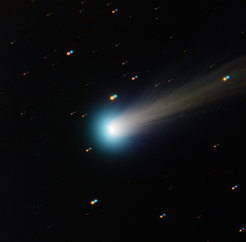Heavy stellar traffic, deflected comets, and a closer look at the triggers of cosmic disaster
As stars pass close by our solar system, they can nudge comets from the distant Oort cloud into the inner regions around the Sun. Thus, stellar encounters are an important factor in determining the risk of large cosmic impacts on Earth. Now, Coryn Bailer-Jones from the Max Planck Institute for Astronomy has used data from the ESA satellite Gaia to give the first systematic estimate of the rate of such close stellar encounters. Every million years, up to two dozen stars pass within a few light-years of the Sun, making for a near-constant state of perturbation. The results have been published in the journal Astronomy & Astrophysics.
| Background information | Download area | In-depth description of the results |

Bild des Kometen C/2012 S1 (ISON), aufgenommen mit dem TRAPPIST-Süd-Teleskop am La Silla-Observatorium der ESO im Jahre 2013. Dieser Komet stammt wahrscheinlich aus der Oort'schen Wolke, befindet sich aber definitiv nicht auf Kollisionskurs mit der Erde. Er zeigt das typische Erscheinungsbild von Kometen, die im inneren Sonnensystem ankommen: einen riesigen Schweif aus Gas und Staub.
Comets colliding with Earth are among the more violent and extensive cosmic catastrophes that can befall our home planet. The best known such impact is the one which, 66 million years ago, caused or at least hastened the demise of the dinosaurs (although it is not known whether the blame in this case falls on a comet or an asteroid).
It must be said that, to the best of current knowledge, impacts with regional or even global consequences are exceedingly rare, and occur at a rate of no more than one per million years. Also, monitoring systems give us a fairly complete inventory of larger asteroids and comets, none of which is currently on a collision course with Earth.
Still, the consequences are serious enough that studies of the causes of comet impacts are not purely academic. The prime culprits are stellar encounters: stars passing through our Sun's cosmic neighborhood. The outskirts of our solar system are believed to host a reservoir of cold and icy objects – potential comets – known as the Oort cloud. The gravitational influence of passing stars can nudge these comets inwards, and some will begin a journey all the way to the inner solar system, possibly on a collision course with Earth. That is why knowledge of these stellar encounters and their properties has a direct impact on risk assessment for comet impacts.
Now, Bailer-Jones has published the first systematic estimate of the rate of such stellar encounters. The new result uses data from the first data release (DR1) of the Gaia mission that combines new Gaia measurements with older measurements by ESA's Hipparcos satellite. Crucially, Bailer-Jones modeled each candidate for a close encounter as a swarm of virtual stars, showing how uncertainties in the orbital data will influence the derived rate of encounters.
Bailer-Jones found that within a typical million years, between 490 and 600 stars will pass the Sun within a distance of 16.3 light-years (5 parsecs, to use a unit more common in professional astronomy) or less. Between 19 and 24 stars will pass at 3.26 light-years (1 parsec) or less. All these hundreds of stars would be sufficiently close to nudge comets from the Oort cloud into the solar system. The new results are in the same ballpark as earlier, less systematic estimates that show that when it comes to stellar encounters, traffic in our cosmic neighborhood is rather heavy.
The current results are valid for a period of time that reaches about 5 million years into the past and into the future. With Gaia's next data release, DR2 slated for April 2018, this could be extended to 25 million years each way. However, astronomers intending to go even further and search for the stars that might be responsible for hurling a comet towards the dinosaurs will need to know our home galaxy and its mass distribution in much more detail than we currently do – a long-term goal of the researchers involved in Gaia and related projects.
Background information
The research described here is published as C. A. L. Bailer Jones, "The completeness-corrected rate of stellar encounters with the Sun from the first Gaia data release" in the journal Astronomy & Astrophysics.
- E-print on arXiv
- ESA picture of the week (available after embargo time ends)
- ESA press release (available after embargo time ends)
Additional figures and download

